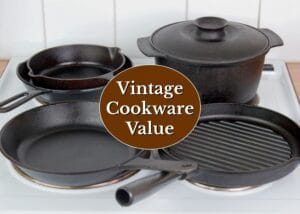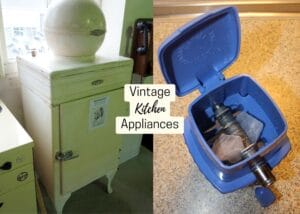Do you have some old pots in your attic, and you’re planning to sell them? If yes, you need to STOP and read this! Recently, a friend of mine bought a rusty old skillet for $3 at a flea market. Turned out, it was a rare Griswold that had sold on eBay for over a thousand dollars.
Vintage cookware isn’t just old utensils anymore; it’s attracting many eyes (and commanding premiums) due to its old and sturdy make that lets people cook in a 100-year-old pan.
So, before you sell your pots for just a few bucks, check this guide to find out whether they are valuable antiques worth thousands!
3 Key Signs to Spot Old Antique Cookware!
Finding out whether or not an old cookware piece is antique is not as challenging as it seems, given that you know what signs to look for, like materials, construction methods, design features, and markings.
Once you learn how to read these features, you can easily spot the difference between a real old Griswold skillet and a modern pan.
1. Markings & Stamps
The first step to authenticating any old cookware is to look for markings. Turn over the piece and you’ll find certain marks on the bottom (sometimes on the handles), like names, logos, numbers, letters, and symbols. These marks are real clues about who made it and when.
Below are some of the most renowned cookware manufacturers and tips to identify their pieces:
- Griswold Manufacturing Company: Griswold ruled the cookware industry from 1865 to 1957. Early pieces just say “ERIE” on the bottom, with no company name. Later pieces show “ERIE” (1880s-1909), the cross-and-circles logo (1909-1930s), large block letters (1930-1939), and small block letters (1939-1957).
- Wagner Manufacturing Company: Also known for their smooth surfaces, Wagner cookware shows from 1891 to 1952, shows a stylized “W.” Post-1914 pieces may show the “Wagner Ware Sidney-O” stamp. Some pieces also feature the “pie logo,” which only lasted about ten years, making them rare.
- Lodge Manufacturing Company: Established in 1896, this is America’s oldest continuously operating cast iron foundry. You can date Lodge pieces by heat ring notches: no notches (1910-1930), single notch (1930-1940), and three notches (1940-1992). Also, the famous egg-in-skillet logo is common from 1973-present).
- Favorite Piqua Ware (1916-1935): Known for their lightweight, high-quality, but less costly cast iron cookware! Early Piqua cookware shows “FAVORITE” arched over “PIQUA WARE” in block letters, 1920s pieces used various fonts and scripts, and 1920s-1935 pieces have the “smiley” logo, a curved line under the company name.
Also, some pieces can show size numbers, pattern or model numbers, or casting marks on the bottom. You could cross-check them with brand catalogs or collector guides.
But if a pot or pan is so old that you can hardly see the brand name, logo, or numbers, use the following features to authenticate it.
2. Materials
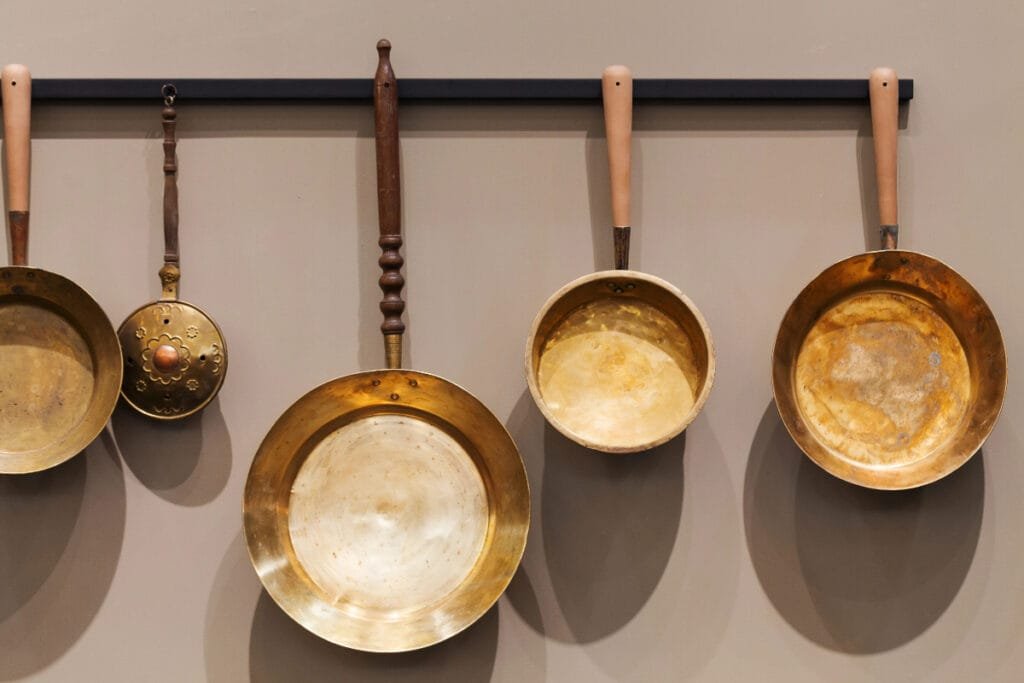
The material of old cookware is the first thing that tells whether it’s antique or not, or how old it possibly is. The earlier items were all made of cast iron, but with time, makers began using other materials as well.
Here’s how you can date and identify vintage cookware by materials:
Cast Iron:
The earliest and most prominent antique cookware material! Pre-1900 pieces were hand-polished after casting, making the surface silk-smooth. Hand-molded pieces also show gate marks (rough lines across the bottom), while Early 1900s mass-produced pieces have pebbled or matte surfaces with side-gated seams.
Copper:
Real vintage copper feels seriously thick and heavy, with 19th-century pieces flaunting a hand-hammered body with wrought-iron or brass-riveted handles. If you see machine-rolled, stamped copper with uniform thickness, it’s an early 1900s make.
Also, old copper was lined with tin, while modern pieces use stainless steel lining.
Enamelware:
This entered American kitchens around the late 19th century, with single-coat, thick porcelain pieces dating to the 1920s-1940s. Thin, multicolor, or patterned enamels hint at the 1950s onward.
Early enamelware was stamped from thin iron or steel sheets, so it feels light. But quality vintage enameled cast iron, like Le Creuset pieces, is heavy.
Cast Aluminum:
Aluminum cookware became popular in the 1890s, with pieces made of plain aluminum without any special markings and wooden or bakelite handles usually dating before 1934. Post-1950s aluminum pieces usually have all-metal bodies.
Pyrex Glassware:
Pyrex cookware came into existence around 1915 and drastically changed antique cookware. It’s made of borosilicate glass that handles temperature changes much better than today’s soda-lime glass.
There are no particular clues to spot Pyrex, but the bright colors and specific patterns are distinctive signs of authentic vintage pieces.
3. Construction Clues & Design Details
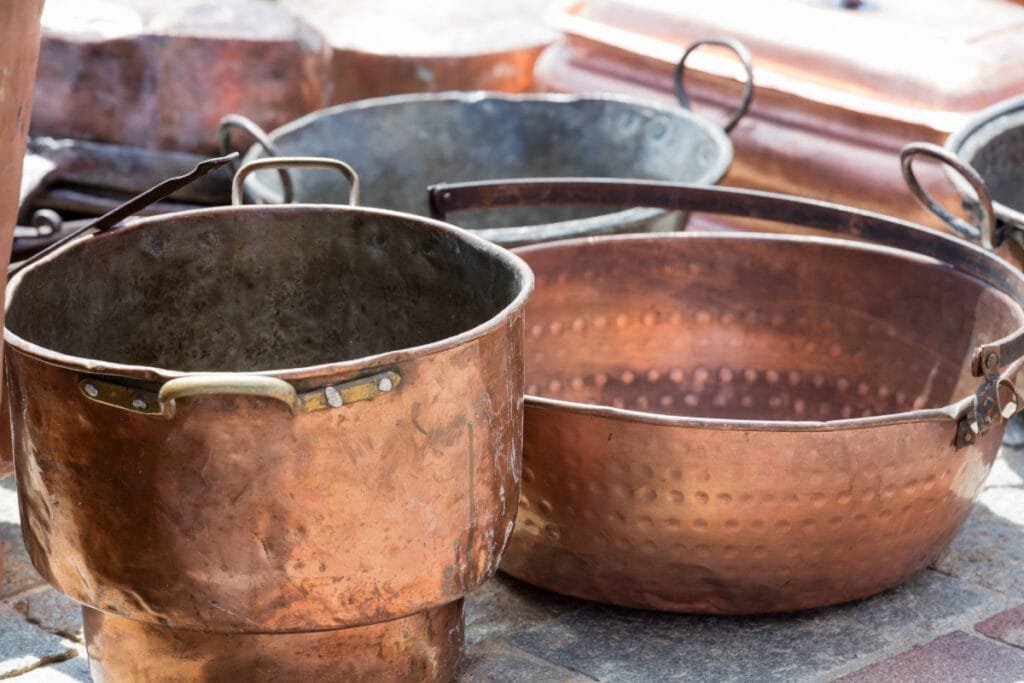
The technique used to make a cookware piece and its design can offer subtle hints of age and genuineness. So, pay attention to the following features:
Mold Make – Gate Marks
Old cast iron was made by pouring molten metal into sand molds, leaving gate marks – raised, rough lines or scars across the bottom (mostly where molten iron was poured into the mold). This technique was standard in the 1800s and early 1900s before manufacturers switched to side-gating.
So, if you find a gate mark, you’re probably looking at a 19th-century cookware piece.
Heat Rings and Notches
Most early and authentic pots, pans, and skillets have little rims on the bottoms, called heat rings, specifically made for wood-burning stoves to distribute heat evenly. But once gas and electric stoves took over, heat rings disappeared. So, heat rings mean your skillet is really old.
Some brands, like Lodge, even used notches in these rings as dating markers. For instance, early Lodge pans that we discussed earlier!
Handle & Lid Details
The details on the handles of old cookware can also be surprisingly helpful in knowing more about it. For instance, early Revere Ware from 1939-1947 had two screws positioned close together on the handle; pieces from 1947-1968 have screws on opposite ends.
Also, for lidded pieces, check how well the lid fits; quality vintage pieces like Griswold’s “Tite-Top” lids seal perfectly. Besides, if the lid doesn’t fit properly, it could mean it does not belong to that pot or pan.
How to Tell If Old Cookware Is Valuable?
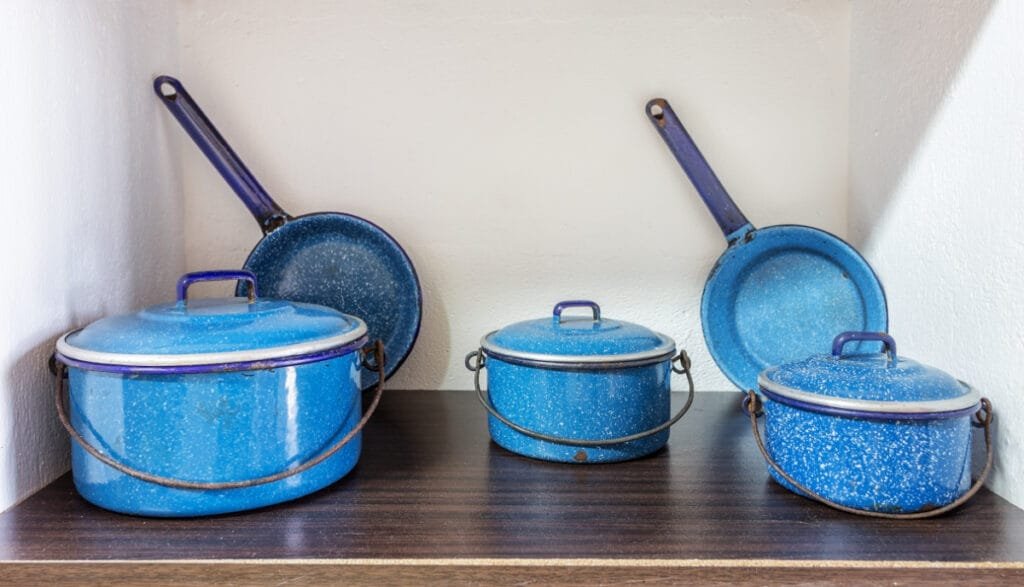
To find out whether your old skillet is worth just a few bucks or thousands, you need to assess the following factors:
1. Age
Naturally, older cookware is more valuable than modern pieces. While you can use the above-mentioned clues to date your piece, certain aging signs will further authenticate whether your cookware is really old or “is made to look old!”
- Uniform, smooth “black satin” patina on cast iron pieces
- Golden-brown tin lining on copper pieces
- Faded crazing in enamelware
- Light surface scratches
- Rounding of pour spouts/handles
- More wear on high-contact areas (center of cooking surface, spout edges, & handles)
If you see some or all of the above signs, you’re holding a valuable vintage cookware item!
2. Condition & Functionality
For antique cookware, condition is a huge value factor, because nobody wants a broken or worn-out piece. While light damage (like the signs mentioned above) is a sign of natural aging and usage, heavy damage can seriously devalue old pieces. So, look for the following:
- Deep pitting, corrosion holes, & severe warping in cast iron pieces
- Overzealous cleaning (acid stripping) or re-seasoning
- Serious chips and cracks or dishwasher damage (the “sick glass” look) for glass cookware
- Flaking or spalling in enamelware
- Faded or worn-away markings
- Deep gouges, scratches, or dents
In short, the answer to the question “Can you still cook with it?” is what drives the value of antique cookware (especially for cast iron).
That’s why ready-to-use antique cookware pieces with intact original seasoning (“black satin”) and lining and minimum damage are worth more than a rusty piece that needs restoration.
3. Rarity & Desirability
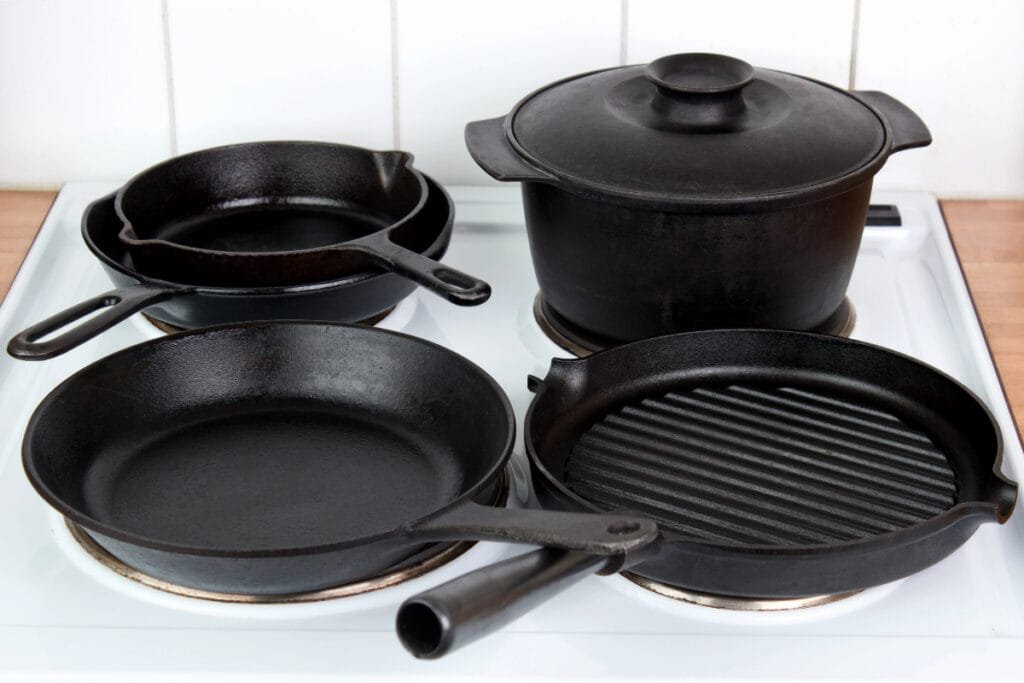
If an old cookware piece is rare and difficult to find, it automatically becomes more desirable. But how will you know what makes it rare?
The following signs will tell you whether your cookware is rare or not:
- Limited production piece: Examples that belong to a limited edition line are generally more desirable. Some examples are the Griswold “spider skillet” (known for its unique spider emblem) and
- Unusual sizes: Some cookware sizes were released in smaller quantities, making them harder to find. The Griswold #2 skillet is a perfect example; it has sold for over $1,000 because tiny skillets are hard to find.
- Discontinued colors: Colored antique cookware is generally rare to find, especially discontinued ones. Le Creuset had dropped colors like Cobalt Blue and Kiwi Green over the years. People building complete color collections can pay almost anything for these.
4. Completeness
Although not primarily, completeness plays a big role in determining old cookware’s worth, because a Dutch oven without its lid is like a car without wheels—it might still be valuable, but not nearly as much.
Complete cookware sets with all original parts command serious money because they’re harder to find. So, make sure to look for original handles, helper grips, and matching accessories.
Also, collectors tend to pay double for a complete set versus individual pieces. I found this full set of 10 Wapak Indian Head Skillets (#3 to #12) sold for an eye-popping price of almost $10,500 on eBay!
Apart from this, documentation like original packaging, instruction booklets, or even old sales receipts can add hundreds to the value. These items provide the backstory that collectors generally like to have!
11 Rare Antique Cookware Pieces Worth Collecting!
I searched and picked some real-time examples of antique vintage cookware pieces that are actually worth a lot, not just in words but also in numbers.
1. Small Cast Iron Bean Pot Kettle
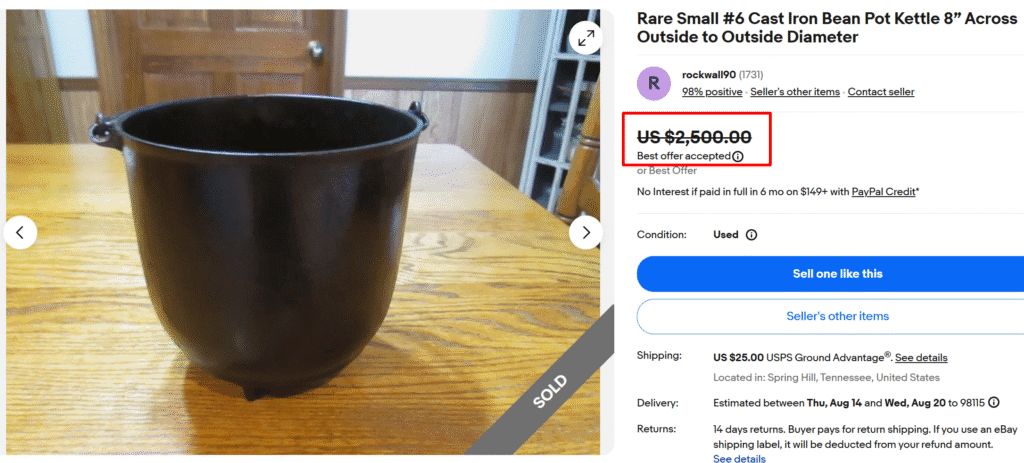
This rare 8-inch bean pot shows early American cast iron work from the 1800s. For example, the unique three-legged design that allows it to sit over coals, and the wire bail handle make it easy to move around campfires.
Bean pots like this were essential for frontier cooking (beans could simmer for hours while families worked). While this one doesn’t have a high-end name to it, the small size (#6) makes it worth the price tag of $2,500 because most bean pots were larger (smaller ones are rare)!
2. Griswold #2 Cast Iron Skillet
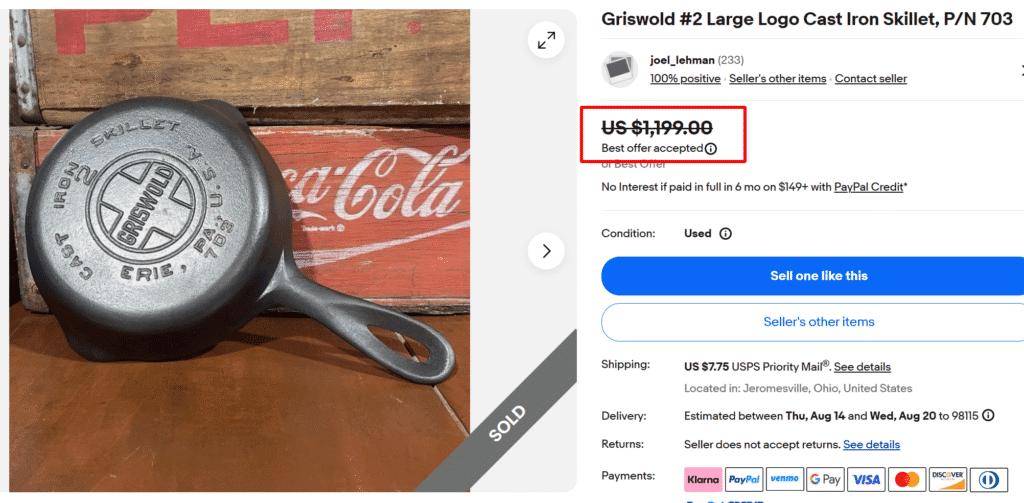
This tiny 6-inch Griswold skillet is truly a rare find since small skillets are rather scarce today because they were less practical for most cooking needs. This piece is a perfect example of rare Griswold cookware that collectors can pay thousands for!
Made between 1920-1940, these pieces feature the coveted “Large Block Logo” marking with “Erie, PA, U.S.A.” and the pattern number 703 to authenticate them. If you find one, you’re lucky!
3. E. Dehillerin Hammered Copper Stock Pot Pan
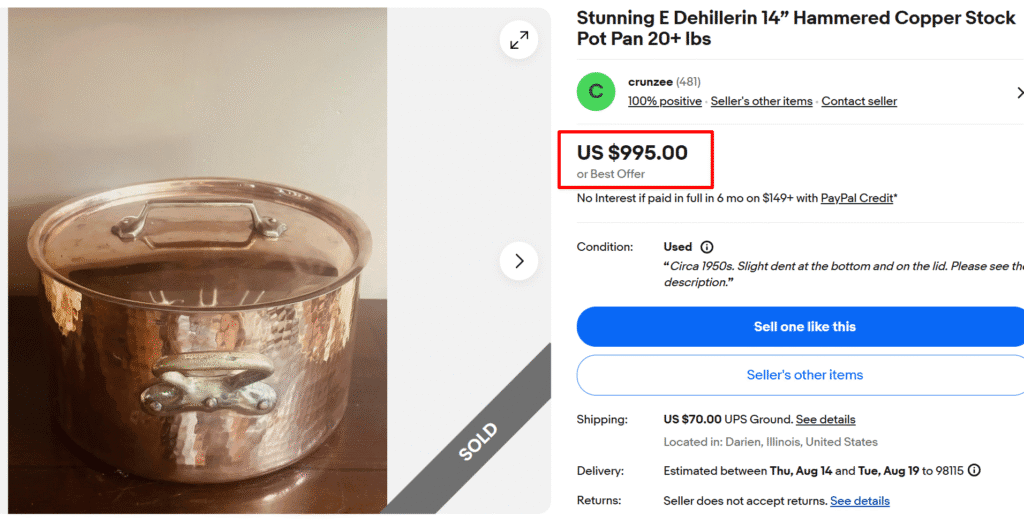
This stunning French copper pot comes from Paris’s legendary E. Dehillerin, the cookware shop that supplied Julia Child. Dehillerin was founded in 1820 and quickly became known for professional-quality copper cookware.
You can spot the genuine pieces by the hand-hammered finish (to strengthen the copper and distribute heat). Massive copper pieces like this 14-inch pot with old-world craftsmanship are nearly impossible to find today.
4. Wapak Indian Head Cast Iron Waffle Iron
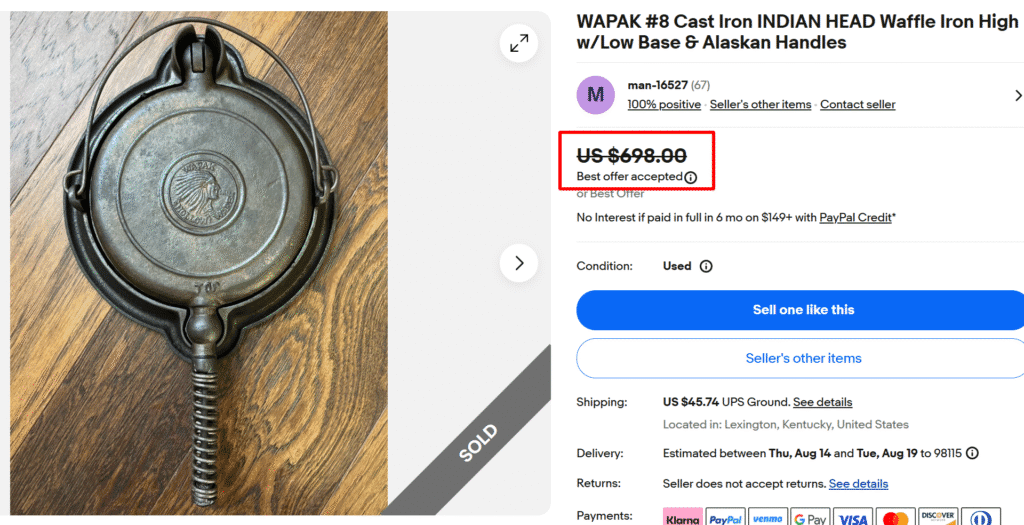
This is a super, premium quality antique waffle iron from Ohio’s Wapak Hollow Ware Company. You can spot this piece by the coveted “Indian Head” medallion logo, a raised Native American chief’s profile.
Besides, the high/low base design with those distinctive “Alaskan handles” (spiral grips) was specially made for wood-burning stoves.
Wapak only made Indian Head pieces for about 23 years, making them rare today. Also, they created some of the most detailed logos in cast iron history that set their pieces apart.
5. Griswold Erie Spider Series Cast Iron Tea Kettle
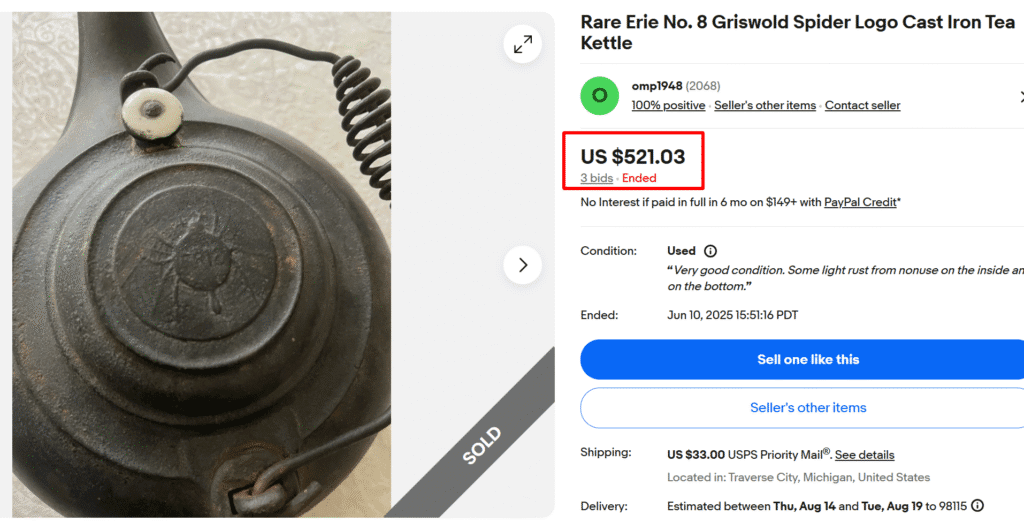
This is a piece from Griswold’s iconic “spider” line that ran only briefly around 1890-1891, making it one of the rarest markings in cast iron history. Nobody knows exactly why Griswold used this eight-legged spider design or why they quickly abandoned it.
While most people look out for spider skillets, large tea kettles, like this example, are also exceptionally rare because most people actually used them until they wore out. You’ll also find the distinctive spiral handle with beautiful craftsmanship.
This piece sold for over $520, but generally, any spider logo piece is quite valuable today!
6. Le Creuset FIFA World Cup Soccer Ball Dutch Oven
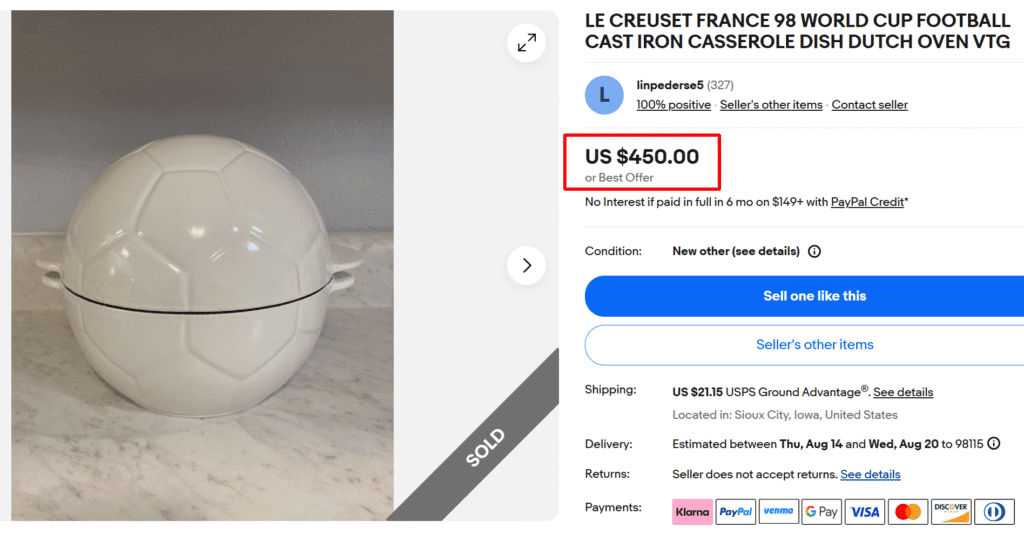
This is an example of how limited edition and historical significance make even not-so-old pieces valuable! This unique soccer ball-shaped casserole was Le Creuset’s limited edition tribute to France hosting (and winning) the 1998 World Cup.
Made from their signature enameled cast iron, it’s both functional cookware and sports memorabilia. The piece uses white enamel for the classic soccer ball design and a cast iron core that provides Le Creuset’s famous heat retention.
Le Creuset only produced these for that specific year, making them incredibly rare today!
7. Antique Graniteware Enamel Pot with Lid
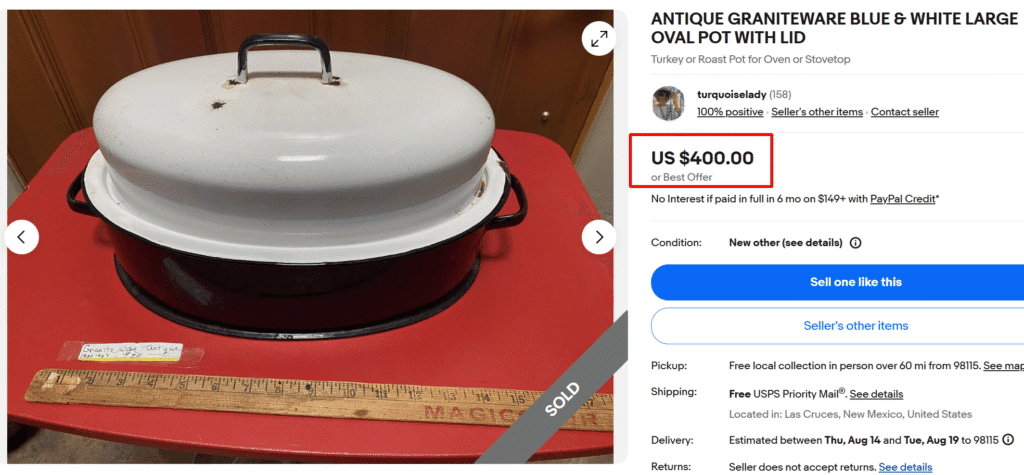
This beautiful speckled enamelware is a true example of classic American kitchenware from the early 1900s. Graniteware (also called enamelware), which is steel coated with porcelain enamel to prevent rust and metallic tastes, was the miracle cookware of its time.
The blue and white speckled pattern was incredibly popular because it looked clean and sanitary. Most graniteware shows chips and wear because people used it every day, so finding pieces, especially large roasting pots like this, in good condition is quite difficult.
8. Wagner Magnalite Aluminum Turkey Roaster
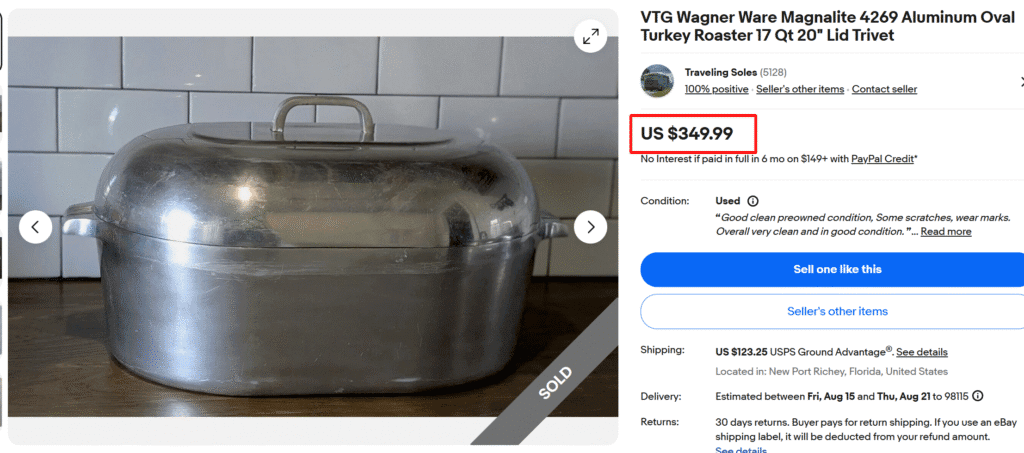
This massive 17-quart oval roaster belongs to Wagner’s premium “Magnalite” line from the 1950s-60s. Made from a patented aluminum-magnesium alloy, it was designed for serious holiday cooking.
Wagner marketed Magnalite as “cast aluminum” that heated faster than cast iron but retained heat like copper. Wagner aluminum roasters are valuable because they’re virtually indestructible and still outperform many modern roasters.
9. Vintage Lodge Cast Iron Skillet
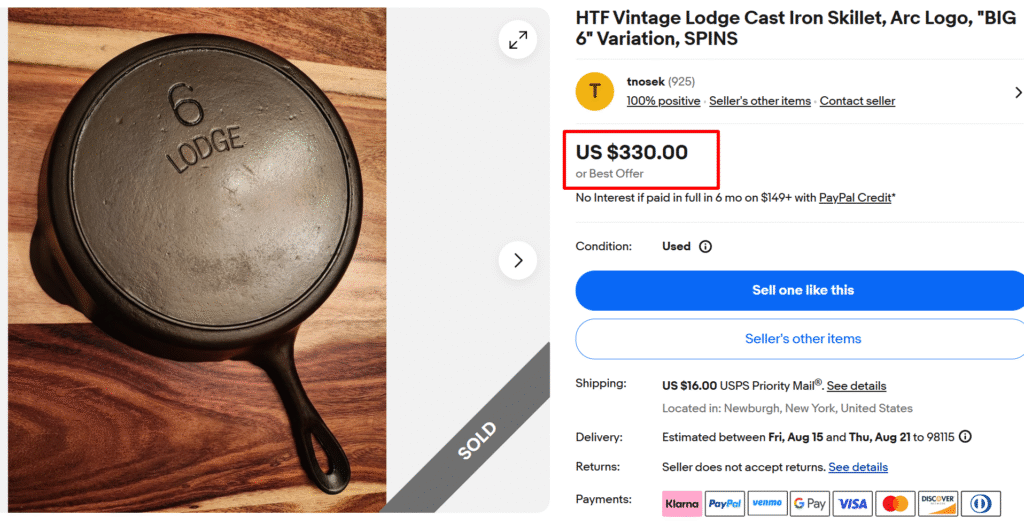
Here is a large-size vintage skillet from America’s oldest cookware company (founded in 1896). The unique “arc logo” puts this piece somewhere between 1910 and 1940, before Lodge switched to their modern marking.
You can spot original Lodge cookware by the perfectly smooth cooking surface. Another interesting fact that makes this piece rare is the “BIG 6” variation, which was Lodge’s marketing claim that their pans were slightly larger than their competitors’!
10. Vintage Pyrex Cranberry Glass Cookware Set
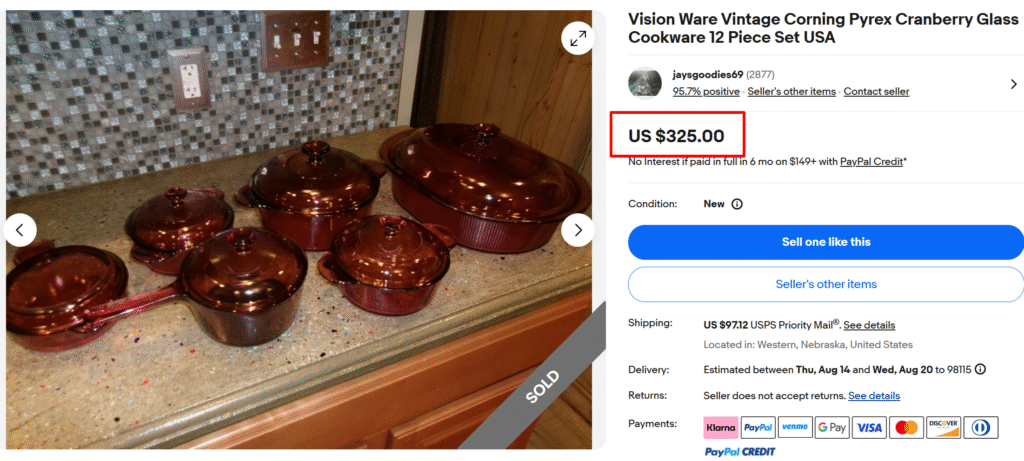
This is a popular cranberry-colored Pyrex cookware set from Corning’s iconic “Vision” cookware line from the 1990s. Made from transparent Pyroceram glass-ceramic, these pieces could go from freezer to stovetop to oven without breaking.
Also, the cranberry color was only available from 1992-2004, making complete sets like this worth a lot. What makes Vision cookware unique is that, unlike regular glass, it can withstand temperatures up to 1,560°F; no wonder they’re sold for hundreds!
11. Griswold Cast Iron Low Dome Skillet Lid
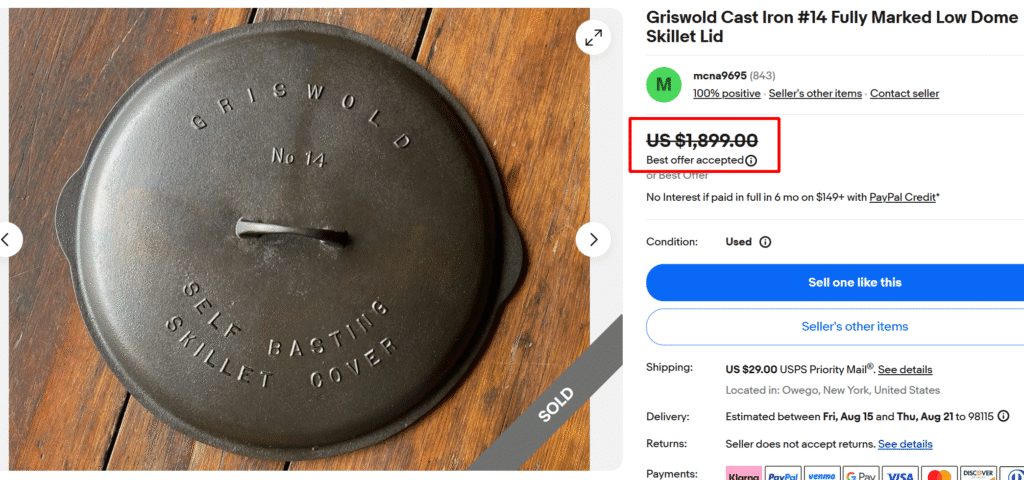
While it’s just a skillet lid, this example shows how collectible and valuable antique Griswold cookware actually is! It’s a well-preserved cast iron lid of skillet #14 (a massive pot) featuring all clear markings, including the brand name, model number, and the “Self Basting Cover” design.
The high price of almost $1,900 shows how collectors cherish even incomplete sets of rare antique cookware.
Note: This article is intended for informational, educational, and entertainment purposes only. Some images are illustrative and may not represent actual brands, products, or related entities. All trademarks, product names, brand logos, packaging, and other intellectual property referenced remain the exclusive property of their respective owners. Any brand mentions or references are provided solely for descriptive and educational context and do not imply any formal or commercial association.

